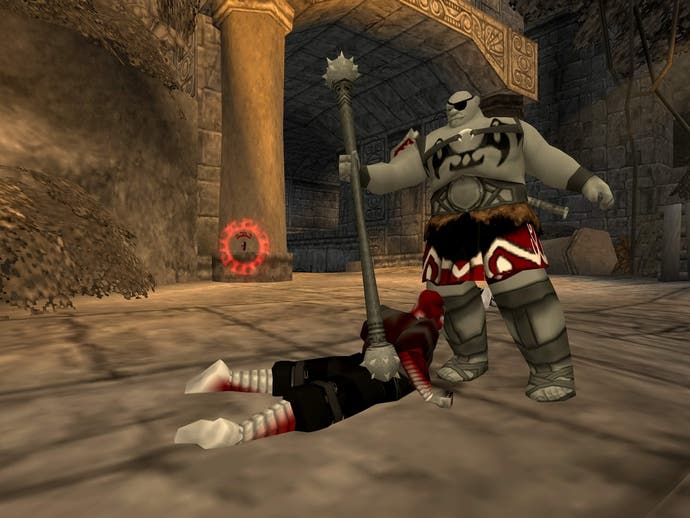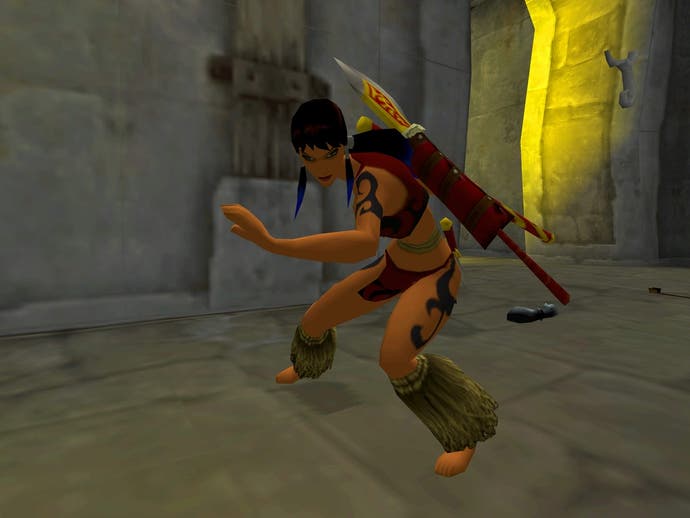Rise of the Kasai
Fans of Kri will want to mark it on the shopping list.
Rise of the Kasai may fail to quench our thirst for what it's best at, but in that sense it's rather like waking up in the middle of the night and guzzling your bedside glass of water; it's so welcome and refreshing that it's hardly surprising you're left wanting more. It isn't struggling to distinguish itself. Instead it seems to be operating in a vacuum; a project often bereft of the marks of conformity that often leave us cold. The name on the spine is symbolic of this: although Rise of the Kasai is the sequel to The Mark of Kri, it feels no compunction in bucking the trend of whacking on a '2'.
For those who never played the original - and given the sales figures for the game's PAL release, that's the vast majority of you - it more or less stands alone, and should you give it time to blossom may well hook you in with its elegant storytelling approach - a mixture of pencil-drawn cut sequences, gravely narration from spirit guide Kuzo, and the soothing tones of the oracle - and unconventional third-person combat. It's also one of the most unapologetically brutal games in living memory, full of grisly finishing moves and acrobatic swordplay that belies the undercurrent of spirituality and honourable intention, framed in-game by cartoon visuals that call to mind Disney's Mulan with barrel-chested warriors and lithe assassins carving their way through temple ruins, Arabian cities and treacherous mountain passes.
Following the events of The Mark of Kri, which saw the warrior Rau trying to defend the power of the mark itself from the forces of evil by beating a ferocious path to the heart of the problem (and then stabbing it), the sequel kicks off on a bombshell. Rau's dead. The player now has to relive critical periods leading up to his demise at the hands of a betrayer as well as playing out events in the present, assuming the roles of Rau himself, his sister Tati and his key companions the mighty warrior Baumusu and mentor Griz, as the tale of the evil Kasai's rise is spelt out and, hopefully, refashioned with a happier ending.

This means there's greater variation in approach, as certain levels are given over to the bulldozing might of Baumusu's weighty mace or his companion Griz's vicious acrobatics, while others are afforded to Tati and Rau, whose skills in combat differ and whose propensity for emphatic stealth takedowns help break up the ruckus and drums your heart at a different rate. The use of multiple characters has also led the designers to craft branching levels that see you split up from your computer-controlled companion and rejoin them for key battles, which can therefore take place on a much grander scale reminiscent of the first game's latter stages right from the off. Speaking of scale, the inclusion of some boss battles ups it further; the original, of course, barely even had an end boss.
In practice most of the mechanics remain the same. Certainly the game's curious multi-target combat system is unchanged. You still use the right analogue stick to swing a glowing red targeting "arm" around and mark multiple enemies, each of whom can then be attacked directly by hammering the face button bearing the symbol above their head; and combination attacks are still applied by beginning with the appropriate face button and then stabbing at (and with) those that remain unassigned to an enemy elsewhere. Some of the results are astonishing; Griz, for example, will plant his knives in an enemy's skull, solemnly observe the screaming for a couple of seconds and then grab the handles and hurl his hapless victim across the battleground.
Stealth kills adopt a similar approach. By sheathing weapons, Tati, for example, will go into a creeping stance allowing you to sneak up, target your enemies and dispatch them while their backs are turned. You can even target multiple enemies and take them out by performing the second button combination as the first stealth kill action plays out - with a clever use of sound effects to indicate you've done it correctly. And, as numbers of enemies, complexity of movement patterns and the pressures of time start to conspire, much like The Mark of Kri this game becomes far more compelling and exhilarating.

Meanwhile the violent end product, often some sort of neck-slashing horror, is like an exclamation mark on the end of your adrenal medulla. The question some will ask, of course, is whether the game goes too far. Grabbing and forcing an enemy to the ground and then pulling his head back until his neck snaps is the sort of worrying terror that Manhunt so guiltlessly perpetrated and was berated for. Mind you, I'm a bit more contented by Tati's motivation - these people have hunted for her for all of her 21 years, after all - but it's still a little discomforting. And Rise of the Kasai is unquestionably one for squeamish gamers to avoid.
At this point, though, I'm very much enjoying it. Combat and stealth are both thoughtfully done, and stealth in particular requires careful mastery of your various tools. The more complex levels can be like little mazes, where finding the perfect route to undo everyone without letting them swing a sword in anger is compulsive enough that you'll restart whole sections just to do better. Fortunately, although the third-person camera can be clunky, observing guard patterns is aided by the ability to dispatch your spirit guide to various vantage points and survey the scene. This is something you'll want to do whether you're all stealth or all muscle, because as before there are horn-blowers dotted around who can signal for reinforcements. And in a nice touch above and beyond the first game's efforts, not only do these foes spill out of nearby tents and doorways, but, for example, on one level they signal a longboat out to sea which then turns in and sails menacingly toward the jetty where troops disembark.
Rise of the Kasai also remains very exacting and single-minded in its approach. Despite the cartoon visuals it refuses to succumb to being part-platformer, so it's impossible to fall off ledges you're not meant to. It's all about the confrontation, whether or not the protagonists are both clued in on it before heads (literally) start to roll. And like the original it's aware that players will derive satisfaction not only from achieving things as painlessly as possible - at least on their side - but by perfecting other areas, and as such incorporates level-specific challenges like seeking out hidden icons and performing certain combinations against multiple enemies, with unlockables available to those who want to be tested in this manner.

There are some lingering issues in our US retail version. The AI sentries are still unconvincing a lot of the time, animation isn't always as seamless as it could be, and the decision to use buttons unassigned to targets in combo moves can be counterintuitive when you're in the midst of multiple adversaries, and the targeting arm can't help but select more than one. Also, worryingly, your computer-controlled collaborator doesn't always move on when he or she should, and other times alerts horn-blowers when stealth would've been better. These things could prove very costly when it comes to handing down a score.
But, other than that and a few interface issues (like the way "Restart section" takes you to the beginning of a level rather than the last checkpoint), Rise of the Kasai continues in its predecessor's footsteps and expands in terms of narrative and level design without seeking wider acceptance by, I dunno, giving Rau a guitar or something. It's recycling a lot of what's come before, perhaps owing something to the loss of the two-player co-operative approach that the developer originally intended to be the core of the game, but, given the shortness and distinctiveness of the first game, the chance to revisit some of these ideas isn't particularly unwelcome.
Ultimately Rise of the Kasai is probably an acquired taste, but for those who acquired it with The Mark of Kri my first impression after a couple of hours stalking the shadows and scything through horn-blowers is that it'll prove a generous second serving. And, frankly, it's wonderful to see such an underrated but passionately individual little game given license to continue exploring its own distinctive approach. The result, as before, is something quite different to the mainstays of the genre, and it'll be a great pleasure to sit down and give it a more concerted going over on another occasion.
Rise of the Kasai has yet to be given a European release date, but hopefully that will change. It's out now in the US.

